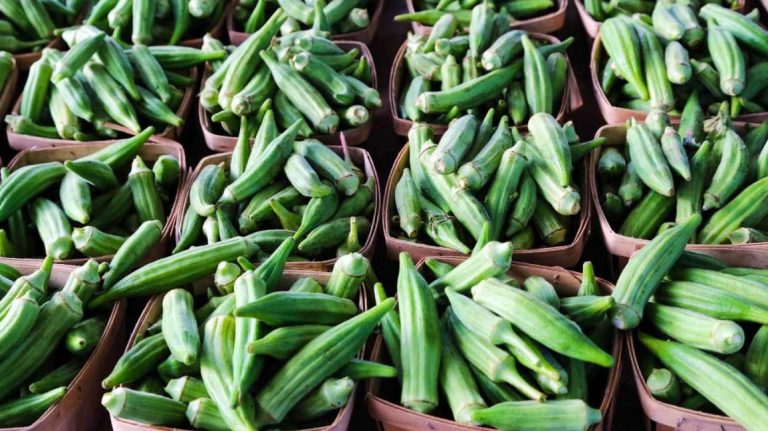
The combined treatment of okra pods with 1-MCP and MAP maintained the visual quality of the product in terms of overall acceptability for four days at 20 ☌ and 20 days at 7 ☌. According to the results, relatively less chilling injury stress also resulted when 1-MCP combined with MAP. The 1-MCP in combination with MAP effectively suppressed respiration rate and ethylene production for four days and eight days at 27 ☌ and 7 ☌ temperature conditions, respectively. Additionally, ascorbic acid and total antioxidants were also retained in 1-MCP with MAP during cold storage. However, MAP with or without 1-MCP was more effective to reduce weight loss in okra stored at both ambient and cold storage conditions. Results revealed that the 1-MCP and/or MAP treatment successfully inhibited fruit softening, reduction in mucilage viscosity, and color degradation (hue angle, ∆E, and BI) in the product resulting in a longer period of shelf-life.

The treated/ untreated okra samples were stored at ambient (i.e., 27 ☌) and low (i.e., 7 ☌) temperatures for eight and 20 days, respectively. Okra possesses a short shelf-life which limits its marketability, thereby, the present study investigates the individual and combined effect of 1-methylcyclopropene (1-MCP) and modified atmosphere packaging (MAP) on the postharvest storage life of okra. Besides, briefly discuss the FW pretreatment methods, the effect of bio-compost on soil properties, and their corresponding effects on the growth of Abelmoschus esculentus L. This research is the consensus on VC as the FW treatment. In this study, the primary research data sources are 78 scientific articles over the last few years. Furthermore, bio-compost produced by the VC method nourishes plant growth.

Among all the composting methods available, vermicomposting (VC) that uses redworms (Eisenia fetida) produces nutrients rich bio-compost, as proven in the existing literature. Most advanced countries have accomplished that the least cost and most efficient FW treatment is composting. This paper reviews the primary FW treatments available in all countries.

The rise in FW does not only influence one’s food supply, yet the greenhouse gas (GHG) emission such as methane (CH4) and carbon dioxide (CO2) gas leads to global warming and health issues. The results of this study are in line with the research conducted by Fauziana on the effect of okra fruit (Abelmoschus esculantus L.) juice on cholesterol levels of mice (Mus musculus L.) BALB-C and their use as leaflets found that the administration of okra fruit juice significantly affected (p = 0,000) to decrease blood cholesterol in rats, where the administration of okra fruit juice at a dose of 0.2 ml / 20 gram body weight of mice is most influential in reducing the total cholesterol level of rats.įood waste (FW) has always been a significant issue faced by almost all countries worldwide. Kahlom, Chapman & Smith (2007) state that Okra polysaccharide lowers the cholesterol level in blood and may pravent cancer by its ability to bind a bile acids. The mucilage of okra binds cholesterol and bile acid carrying toxins dumped into it by the liver. Several recent studiesshowed the beneficial impacts of okra seed and mucilage on improving histopathological changes and biochemical parameters in preclinical studies.Thesestudies found the effectivity of okra seed extract in reducting total cholesterol, lipoproteins containing cholesterol, triglyceride and glucose levels and an enhancement of serum insulin level. Okra seed oil is also a rich source of linoleicĪcid, a polyunsaturated fatty acid essential for human nutrition. Okra seeds are a potential source of oil, with concentrations varyingįrom 20% to 40%, which consists of linoleic acid up to 47.4%. The mucilage of okra binds cholesterol and bile acid carrying Okra mucilage has medicinal applications when used as a plasma Often the extract obtained from the fruit is added to different recipes like stews and It offers mucilaginous consistency afterĬooking. Used in salads, soups and stews, fresh or dried, fried or boiled. Okra immature fruits, which are consumed as vegetables, can be

Okra is a multipurpose crop due to its various uses of the fresh leaves,īuds, flowers, pods, stems and seeds. This paper was aimed to review nutritional quality and potential healthīenefits of edible parts of Okra. Okra is an economically important vegetable crop grown in tropicalĪnd sub-tropical parts of the world.


 0 kommentar(er)
0 kommentar(er)
